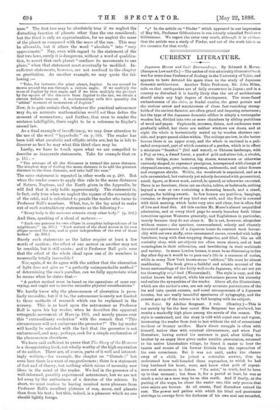CURRENT LITERATURE.
Japanese Homes and their Surroundings. By Edward S. Morse. (Sampson Low and Co.) —The author of this admirably ifinstrated book was for some time Professor of Zoology in the University of Tokio, and appears to have devoted his spare time to the study of Japanese domestic architecture. Another Tokio Professor, Mr. John Milne, tells as that earthquakes are of daily occurrence in Japan ; and in a country so disturbed it is hardly likely that the art of architecture should attain any high degree of development. The stone-faced embankments of the shiro, or feudal castles, the great portals and the curious arrow and watchtowers of these fast-vanishing strong- holds of the ancient daimios, are often grand and imposing structures ; but the type of the Japanese domestic edifice is simply a rectangular wooden box, divided into two or more chambers by sliding partitions of wood and paper. Cupboards, recesses, daises, and outhouses were gradually added, but there are neither windows nor doors, and at night the whole is hermetically sealed up by wooden shutters out- side, and paper-paned slides within. The ceilings are low, in the better houses there is an upper story, and the whole is enclosed in a pali- saded compound, part of which consists of a garden, which is in effect a miniature " Sansbui" (hill and water), or Chinese landscape, with a Fuji or two, a dwarf forest., a pond of gold and silverfish, a rivulet, a little bridge, stone lanterns, big stones, waterworn or otherwise curiously shaped, to represent precipices, interspersed with clumps of chrysanthemums, primulas, euonymus, andromeda, and other flowers and evergreen shrubs. Within, the woodwork is unpainted, and as a rule unvarnished, but variously yet soberly decorated with geometrical, scroll, figure, or flower work, carved, lacquered, or otherwise executed. There is no furniture, there are no chairs, tables, or bedsteads, nothing beyond a vase or two containing a flowering branch, and a stand, perhaps, for holding swords. In few houses are portieres, hangings, curtains, or draperies of any kind met with, and the floor is covered with thick matting, which looks very nice and clean, but is often full of live and dead dirt. All this excites Mr. Morse's almost unqualified admiration, and at every third page he nearly launches forth bitter invectives against Westerns generally, and Englishmen in particular, merely because they do not share it. He is not, however, altogether without reason ; the spacious, unencumbered, soberly and chastely decorated apartments of a Japanese house do contrast most favour- ably with our own stuffy, over-ornamented rooms, crowded with bulky furniture, hung with dust-trapping draperies, and filled, like an old curiosity shop, with art-objects too often mere shams, and at best meaningless in their collocation, and bewildering in their multitude and variety. In some London houses, it must be 118 distressing to live day after day as it would be to pass one's life in a museum of caries, while in many New York brown-stone "edifices," life must be almost maddening. The book gives a faithful and minute account of the home surroundings of the fairly well-to-do Japanese, who are not yet too thoroughly seiyO-ised (Westernised). The style is easy, and the author knows his subject, while his enthusiasm proves his sincerity and enlists the sympathies of the reader. Above all, the illustrations, which are the author's own, are not only accurate portraitures of the ins and outs, quaint corners, and novel arrangements of a Japanese interior, but are really beautiful specimens of xylography, and the general get-up of the volume is in fall keeping with its subject.


































 Previous page
Previous page